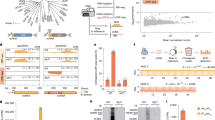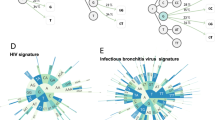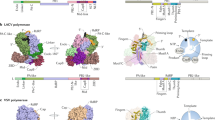Abstract
Rapid progress in DNA synthesis and sequencing is spearheading the deliberate, large-scale genetic alteration of organisms. These new advances in DNA manipulation have been extended to the level of whole-genome synthesis, as evident from the synthesis of poliovirus, from the resurrection of the extinct 1918 strain of influenza virus and of human endogenous retroviruses and from the restructuring of the phage T7 genome. The largest DNA synthesized so far is the 582,970 base pair genome of Mycoplasma genitalium, although, as yet, this synthetic DNA has not been 'booted' to life. As genome synthesis is independent of a natural template, it allows modification of the structure and function of a virus's genetic information to an extent that was hitherto impossible. The common goal of this new strategy is to further our understanding of an organism's properties, particularly its pathogenic armory if it causes disease in humans, and to make use of this new information to protect from, or treat, human viral disease. Although only a few applications of virus synthesis have been described as yet, key recent findings have been the resurrection of the 1918 influenza virus and the generation of codon- and codon pair–deoptimized polioviruses.
This is a preview of subscription content, access via your institution
Access options
Subscribe to this journal
Receive 12 print issues and online access
$259.00 per year
only $21.58 per issue
Buy this article
- Purchase on SpringerLink
- Instant access to full article PDF
Prices may be subject to local taxes which are calculated during checkout



Similar content being viewed by others
References
Keasling, J. The promise of synthetic biology. The Bridge 35, 18–21 (2005).
Chan, L.Y., Kosuri, S. & Endy, D. Refactoring bacteriophage T7. Mol. Syst. Biol. 1, 2005.0018 (2005).
Burns, C.C. et al. Modulation of poliovirus replicative fitness in HeLa cells by deoptimization of synonymous codon usage in the capsid region. J. Virol. 80, 3259–3272 (2006).
Coleman, J.R. et al. Virus attenuation by genome-scale changes in codon pair bias. Science 320, 1784–1787 (2008).
Mueller, S., Papamichail, D., Coleman, J.R., Skiena, S. & Wimmer, E. Reduction of the rate of poliovirus protein synthesis through large-scale codon deoptimization causes attenuation of viral virulence by lowering specific infectivity. J. Virol. 80, 9687–9696 (2006).
Wöhler, F. Ueber die künstliche Bildung des Harnstoffs. Ann. Phys. 12, 253–256 (1828) (in German).
Kinne-Saffran, E. & Kinne, R.K. Vitalism and synthesis of urea. From Friedrich Wohler to Hans A. Krebs. Am. J. Nephrol. 19, 290–294 (1999).
Miescher, F. Ueber der chemische Zusammensetzung der Eiterzellen. Med.-Chem. Unters. 4, 441–460 (1871) (in German).
Watson, J.D. & Crick, F.H. Molecular structure of nucleic acids; a structure for deoxyribose nucleic acid. Nature 171, 737–738 (1953).
Brown, D.M. & Todd, A.R. in The Nucleic Acids Vol. 1 (eds. Chargaff, E. & Davidson, J.N.) 409–430 (Academic, New York, 1955).
Agarwal, K.L. et al. Total synthesis of the gene for an alanine transfer ribonucleic acid from yeast. Nature 227, 27–34 (1970).
Khorana, H.G. Total synthesis of a gene. Science 203, 614–625 (1979).
Caruthers, M.H. Gene synthesis machines: DNA chemistry and its uses. Science 230, 281–285 (1985).
Stewart, L. & Burgin, A.B. Whole gene synthesis: a gene-o-matic future. Front. Drug Des. Disc. 1, 297–341 (2005).
Sanghvi, Y. A roadmap to the assembly of synthetic DNA from raw materials. in Working Papers for Synthetic Genomics: Risks and Benefits for Science and Society (eds. Garfinkel, M.S., Endy, D., Epstein, G.L. & Friedman, R.M.) 17–33 (2007).
Stemmer, W.P., Crameri, A., Ha, K.D., Brennan, T.M. & Heyneker, H.L. Single-step assembly of a gene and entire plasmid from large numbers of oligodeoxyribonucleotides. Gene 164, 49–53 (1995).
Pan, W. et al. Vaccine candidate MSP-1 from Plasmodium falciparum: a redesigned 4917 bp polynucleotide enables synthesis and isolation of full-length protein from Escherichia coli and mammalian cells. Nucleic Acids Res. 27, 1094–1103 (1999).
Cello, J., Paul, A.V. & Wimmer, E. Chemical synthesis of poliovirus cDNA: generation of infectious virus in the absence of natural template. Science 297, 1016–1018 (2002).
Gibson, D.G. et al. Complete chemical synthesis, assembly, and cloning of a Mycoplasma genitalium genome. Science 319, 1215–1220 (2008).
Tian, J. et al. Accurate multiplex gene synthesis from programmable DNA microchips. Nature 432, 1050–1054 (2004).
Holley, R.W. et al. Structure of a ribonucleic acid. Science 147, 1462–1465 (1965).
Penswick, J.R., Martin, R. & Dirheimer, G. Evidence supporting a revised sequence for yeast alanine tRNA. FEBS Lett. 50, 28–31 (1975).
Shendure, J.A., Porreca, G.J. & Church, G.M. Overview of DNA sequencing strategies. in Current Protocols in Molecular Biology. (ed. Ausubel, F.M. et al.) Unit 7.1 (John Wiley and Sons, Hoboken, NJ, USA; 2008).
Maxam, A.M. & Gilbert, W. A new method for sequencing DNA. Proc. Natl. Acad. Sci. USA 74, 560–564 (1977).
Sanger, F., Nicklen, S. & Coulson, A.R. DNA sequencing with chain-terminating inhibitors. Proc. Natl. Acad. Sci. USA 74, 5463–5467 (1977).
Lander, E.S. et al. Initial sequencing and analysis of the human genome. Nature 409, 860–921 (2001).
The International Human Genome Mapping Consortium. Finishing the euchromatic sequence of the human genome. Nature 431, 931–945 (2004).
Venter, J.C. et al. The sequence of the human genome. Science 291, 1304–1351 (2001).
Wheeler, D.A. et al. The complete genome of an individual by massively parallel DNA sequencing. Nature 452, 872–876 (2008).
Pennisi, E. Personal genomics. Number of sequenced human genomes doubles. Science 322, 838 (2008).
Taniguchi, T., Palmieri, M. & Weissmann, C. Qβ DNA-containing hybrid plasmids giving rise to Qβ phage formation in the bacterial host. Nature 274, 223–228 (1978).
Weissmann, C., Weber, H., Taniguchi, T., Muller, W. & Meyer, F. Reversed genetics: a new approach to the elucidation of structure–function relationship. Ciba Found. Symp. 66, 47–61 (1979).
Racaniello, V.R. & Baltimore, D. Cloned poliovirus complementary DNA is infectious in mammalian cells. Science 214, 916–919 (1981).
Schnell, M.J., Mebatsion, T. & Conzelmann, K.K. Infectious rabies viruses from cloned cDNA. EMBO J. 13, 4195–4203 (1994).
Collins, P.L. et al. Production of infectious human respiratory syncytial virus from cloned cDNA confirms an essential role for the transcription elongation factor from the 5′ proximal open reading frame of the M2 mRNA in gene expression and provides a capability for vaccine development. Proc. Natl. Acad. Sci. USA 92, 11563–11567 (1995).
Neumann, G. et al. Generation of influenza A viruses entirely from cloned cDNAs. Proc. Natl. Acad. Sci. USA 96, 9345–9350 (1999).
Fodor, E. et al. Rescue of influenza A virus from recombinant DNA. J. Virol. 73, 9679–9682 (1999).
Takeuchi, K., Takeda, M. & Miyajima, N. Toward understanding the pathogenicity of wild-type measles virus by reverse genetics. Jpn. J. Infect. Dis. 55, 143–149 (2002).
Neumann, G., Feldmann, H., Watanabe, S., Lukashevich, I. & Kawaoka, Y. Reverse genetics demonstrates that proteolytic processing of the Ebola virus glycoprotein is not essential for replication in cell culture. J. Virol. 76, 406–410 (2002).
Överby, A.K., Popov, V., Neve, E.P. & Pettersson, R.F. Generation and analysis of infectious virus-like particles of uukuniemi virus (bunyaviridae): a useful system for studying bunyaviral packaging and budding. J. Virol. 80, 10428–10435 (2006).
Komoto, S., Sasaki, J. & Taniguchi, K. Reverse genetics system for introduction of site-specific mutations into the double-stranded RNA genome of infectious rotavirus. Proc. Natl. Acad. Sci. USA 103, 4646–4651 (2006).
Blight, K.J., Kolykhalov, A.A. & Rice, C.M. Efficient initiation of HCV RNA replication in cell culture. Science 290, 1972–1974 (2000).
Taubenberger, J.K., Reid, A.H., Krafft, A.E., Bijwaard, K.E. & Fanning, T.G. Initial genetic characterization of the 1918 “Spanish” influenza virus. Science 275, 1793–1796 (1997).
Reid, A.H., Fanning, T.G., Hultin, J.V. & Taubenberger, J.K. Origin and evolution of the 1918 “Spanish” influenza virus hemagglutinin gene. Proc. Natl. Acad. Sci. USA 96, 1651–1656 (1999).
Reid, A.H., Fanning, T.G., Janczewski, T.A. & Taubenberger, J.K. Characterization of the 1918 “Spanish” influenza virus neuraminidase gene. Proc. Natl. Acad. Sci. USA 97, 6785–6790 (2000).
Basler, C.F. et al. Sequence of the 1918 pandemic influenza virus nonstructural gene (NS) segment and characterization of recombinant viruses bearing the 1918 NS genes. Proc. Natl. Acad. Sci. USA 98, 2746–2751 (2001).
Reid, A.H., Fanning, T.G., Janczewski, T.A., McCall, S. & Taubenberger, J.K. Characterization of the 1918 “Spanish” influenza virus matrix gene segment. J. Virol. 76, 10717–10723 (2002).
Reid, A.H., Fanning, T.G., Janczewski, T.A., Lourens, R.M. & Taubenberger, J.K. Novel origin of the 1918 pandemic influenza virus nucleoprotein gene. J. Virol. 78, 12462–12470 (2004).
Taubenberger, J.K. et al. Characterization of the 1918 influenza virus polymerase genes. Nature 437, 889–893 (2005).
Takehisa, J. et al. Generation of infectious molecular clones of simian immunodeficiency virus from fecal consensus sequences of wild chimpanzees. J. Virol. 81, 7463–7475 (2007).
Lee, Y.N. & Bieniasz, P.D. Reconstitution of an infectious human endogenous retrovirus. PLoS Pathog. 3, e10 (2007).
Becker, M.M. et al. Synthetic recombinant bat SARS-like coronavirus is infectious in cultured cells and in mice. Proc. Natl. Acad. Sci. USA 105, 19944–19949 (2008).
Wimmer, E. The test-tube synthesis of a chemical called poliovirus. The simple synthesis of a virus has far-reaching societal implications. EMBO Rep. 7, S3–S9 (2006).
De Jesus, N., Franco, D., Paul, A., Wimmer, E. & Cello, J. Mutation of a single conserved nucleotide between the cloverleaf and internal ribosome entry site attenuates poliovirus neurovirulence. J. Virol. 79, 14235–14243 (2005).
Toyoda, H., Yin, J., Mueller, S., Wimmer, E. & Cello, J. Oncolytic treatment and cure of neuroblastoma by a novel attenuated poliovirus in a novel poliovirus-susceptible animal model. Cancer Res. 67, 2857–2864 (2007).
van der Werf, S., Bradley, J., Wimmer, E., Studier, F.W. & Dunn, J.J. Synthesis of infectious poliovirus RNA by purified T7 RNA polymerase. Proc. Natl. Acad. Sci. USA 83, 2330–2334 (1986).
Molla, A., Paul, A.V. & Wimmer, E. Cell-free, de novo synthesis of poliovirus. Science 254, 1647–1651 (1991).
Jiang, P. et al. Evidence for emergence of diverse polioviruses from C-cluster coxsackie A viruses and implications for global poliovirus eradication. Proc. Natl. Acad. Sci. USA 104, 9457–9462 (2007).
Claverie, J.M. Viruses take center stage in cellular evolution. Genome Biol. 7, 110 (2006).
Villarreal, L.P. Are viruses alive? Sci. Am. 291, 100–105 (2004).
Ryan, F.P. Viruses as symbionts. Symbiosis 44, 11–21 (2007).
Koonin, E.V., Senkevich, T.G. & Dolja, V.V. Compelling reasons why viruses are relevant for the origin of cells. Nat. Rev. Microbiol. 7, 615 (2009).
Claverie, J.M. & Ogata, H. Ten good reasons not to exclude viruses from the evolutionary picture. Nat. Rev. Microbiol. 7, 615 (2009).
Kitamura, N. et al. Primary structure, gene organization and polypeptide expression of poliovirus RNA. Nature 291, 547–553 (1981).
Racaniello, V.R. & Baltimore, D. Molecular cloning of poliovirus cDNA and determination of the complete nucleotide sequence of the viral genome. Proc. Natl. Acad. Sci. USA 78, 4887–4891 (1981).
Smith, H.O., Hutchison, C.A., III, Pfannkoch, C. & Venter, J.C. Generating a synthetic genome by whole genome assembly: ΦX174 bacteriophage from synthetic oligonucleotides. Proc. Natl. Acad. Sci. USA 100, 15440–15445 (2003).
Taubenberger, J.K. & Morens, D.M. 1918 Influenza: the mother of all pandemics. Emerg. Infect. Dis. 12, 15–22 (2006).
Taubenberger, J.K., Morens, D.M. & Fauci, A.S. The next influenza pandemic: can it be predicted? J. Am. Med. Assoc. 297, 2025–2027 (2007).
Taubenberger, J.K., Hultin, J.V. & Morens, D.M. Discovery and characterization of the 1918 pandemic influenza virus in historical context. Antivir. Ther. 12, 581–591 (2007).
Pekosz, A., He, B. & Lamb, R.A. Reverse genetics of negative-strand RNA viruses: closing the circle. Proc. Natl. Acad. Sci. USA 96, 8804–8806 (1999).
Hoffmann, E., Neumann, G., Hobom, G., Webster, R.G. & Kawaoka, Y. “Ambisense” approach for the generation of influenza A virus: vRNA and mRNA synthesis from one template. Virology 267, 310–317 (2000).
Tumpey, T.M. et al. Existing antivirals are effective against influenza viruses with genes from the 1918 pandemic virus. Proc. Natl. Acad. Sci. USA 99, 13849–13854 (2002).
Kash, J.C. et al. Global host immune response: pathogenesis and transcriptional profiling of type A influenza viruses expressing the hemagglutinin and neuraminidase genes from the 1918 pandemic virus. J. Virol. 78, 9499–9511 (2004).
Kobasa, D. et al. Enhanced virulence of influenza A viruses with the haemagglutinin of the 1918 pandemic virus. Nature 431, 703–707 (2004).
Kash, J.C. et al. Genomic analysis of increased host immune and cell death responses induced by 1918 influenza virus. Nature 443, 578–581 (2006).
Pappas, C. et al. Single gene reassortants identify a critical role for PB1, HA, and NA in the high virulence of the 1918 pandemic influenza virus. Proc. Natl. Acad. Sci. USA 105, 3064–3069 (2008).
Tumpey, T.M. et al. Pathogenicity and immunogenicity of influenza viruses with genes from the 1918 pandemic virus. Proc. Natl. Acad. Sci. USA 101, 3166–3171 (2004).
Tumpey, T.M. et al. Pathogenicity of influenza viruses with genes from the 1918 pandemic virus: functional roles of alveolar macrophages and neutrophils in limiting virus replication and mortality in mice. J. Virol. 79, 14933–14944 (2005).
Taubenberger, J.K. & Morens, D.M. The pathology of influenza virus infections. Annu. Rev. Pathol. 3, 499–522 (2008).
Tumpey, T.M. et al. Characterization of the reconstructed 1918 Spanish influenza pandemic virus. Science 310, 77–80 (2005).
Naffakh, N., Massin, P., Escriou, N., Crescenzo-Chaigne, B. & van der Werf, S. Genetic analysis of the compatibility between polymerase proteins from human and avian strains of influenza A viruses. J. Gen. Virol. 81, 1283–1291 (2000).
Tumpey, T.M. et al. A two-amino acid change in the hemagglutinin of the 1918 influenza virus abolishes transmission. Science 315, 655–659 (2007).
Stevens, J. et al. Glycan microarray analysis of the hemagglutinins from modern and pandemic influenza viruses reveals different receptor specificities. J. Mol. Biol. 355, 1143–1155 (2006).
Ryan, F.P. Human endogenous retroviruses in health and disease: a symbiotic perspective. J. R. Soc. Med. 97, 560–565 (2004).
Bannert, N. & Kurth, R. Retroelements and the human genome: new perspectives on an old relation. Proc. Natl. Acad. Sci. USA 101, S14572–S14579 (2004).
Dewannieux, M. et al. Identification of an infectious progenitor for the multiple-copy HERV-K human endogenous retroelements. Genome Res. 16, 1548–1556 (2006).
Enserink, M. Viral Fossil brought back to life. Science NOW 1101, 4 (2006).
Keele, B.F. et al. Chimpanzee reservoirs of pandemic and nonpandemic HIV-1. Science 313, 523–526 (2006).
Li, W. et al. Bats are natural reservoirs of SARS-like coronaviruses. Science 310, 676–679 (2005).
Baltimore, D. Expression of animal virus genomes. Bacteriol. Rev. 35, 235–241 (1971).
Wimmer, E., Hellen, C.U. & Cao, X. Genetics of poliovirus. Annu. Rev. Genet. 27, 353–436 (1993).
Holland, J. et al. Rapid evolution of RNA genomes. Science 215, 1577–1585 (1982).
Eigen, M. Viral quasispecies. Sci. Am. 269, 42–49 (1993).
Zolotukhin, S., Potter, M., Hauswirth, W.W., Guy, J. & Muzyczka, N. A “humanized” green fluorescent protein cDNA adapted for high-level expression in mammalian cells. J. Virol. 70, 4646–4654 (1996).
Gromeier, M., Wimmer, E. & Gorbalenya, A.E. Genetics, pathogenesis and evolution of picornaviruses. in Origin and Evolution of Viruses (eds. Domingo, E., Webster, R.G. & Holland, J.J.) 287–343 (Academic, New York, 1999).
Porter, D.C. et al. Demonstration of the specificity of poliovirus encapsidation using a novel replicon which encodes enzymatically active firefly luciferase. Virology 243, 1–11 (1998).
Kuge, S., Saito, I. & Nomoto, A. Primary structure of poliovirus defective-interfering particle genomes and possible generation mechanisms of the particles. J. Mol. Biol. 192, 473–487 (1986).
Gutman, G.A. & Hatfield, G.W. Nonrandom utilization of codon pairs in Escherichia coli. Proc. Natl. Acad. Sci. USA 86, 3699–3703 (1989).
Moura, G. et al. Large scale comparative codon-pair context analysis unveils general rules that fine-tune evolution of mRNA primary structure. PLoS ONE 2, e847 (2007).
McKnight, K.L. & Lemon, S.M. Capsid coding sequence is required for efficient replication of human rhinovirus 14 RNA. J. Virol. 70, 1941–1952 (1996).
Goodfellow, I. et al. Identification of a cis-acting replication element within the poliovirus coding region. J. Virol. 74, 4590–4600 (2000).
Fowler, M., Beck, K., Brant, J., Opdyke, W. & Roberts, D. Refactoring: Improving the Design of Existing Code (Addison-Wesley, Boston, 1999).
Dunn, J.J. & Studier, F.W. Complete nucleotide sequence of bacteriophage T7 DNA and the locations of T7 genetic elements. J. Mol. Biol. 166, 477–535 (1983).
Knight, T.F. Engineering novel life. Mol. Syst. Biol. 1, 2005 0020 (2005).
Atlas, R. et al. Statement on the consideration of biodefence and biosecurity. Nature 421, 771 (2003).
Atlas, R. et al. Statement on scientific publication and security. Science 299, 1149 (2003).
National Research Council. Biotechnology in an Age of Terrorism (The National Academies Press, Washington, DC, 2004).
Bügl, H. et al. DNA synthesis and biological security. Nat. Biotechnol. 25, 627–629 (2007).
Garfinkel, M., Endy, D., Epstein, G. & Friedman, R. Synthetic genomics: options for governance. Biosecur. Bioterror. 5, 359–362 (2007).
Acknowledgements
We are indebted to our colleagues who have participated in the work described here and who have in part edited the manuscript, particularly A. Paul and B. Futcher, and we thank J. Shendure, L. Steward and A.B. Burgin for information provided. The work described here was supported partially by US National Institutes of Health (NIH) grants AI075219 and AI15122 and contract N65236 from the US Defense Advanced Research Project Agency to E.W.; and partially by the intramural research program of the NIH and the National Institute of Allergies and Infectious Diseases (NIAID). The findings and conclusions in this report are those of the author(s) and do not necessarily represent the views of the funding agency.
Author information
Authors and Affiliations
Corresponding author
Rights and permissions
About this article
Cite this article
Wimmer, E., Mueller, S., Tumpey, T. et al. Synthetic viruses: a new opportunity to understand and prevent viral disease. Nat Biotechnol 27, 1163–1172 (2009). https://doi.org/10.1038/nbt.1593
Published:
Issue date:
DOI: https://doi.org/10.1038/nbt.1593
This article is cited by
-
CRISPR–Cas-mediated chromosome engineering for crop improvement and synthetic biology
Nature Plants (2021)
-
Sequence analysis of SARS-CoV-2 genome reveals features important for vaccine design
Scientific Reports (2020)
-
Attenuation of Viruses by Large-Scale Recoding of their Genomes: the Selection Is Always Biased
Current Clinical Microbiology Reports (2018)



